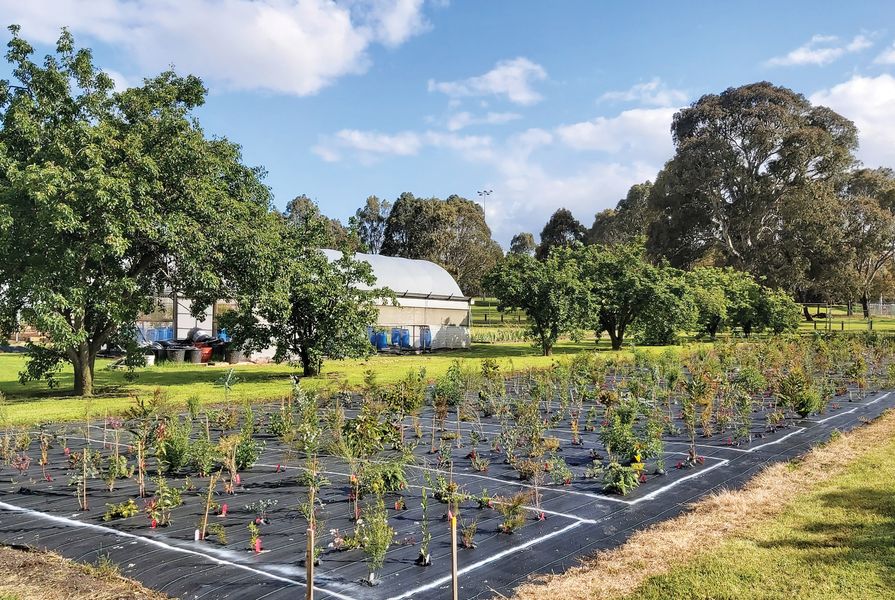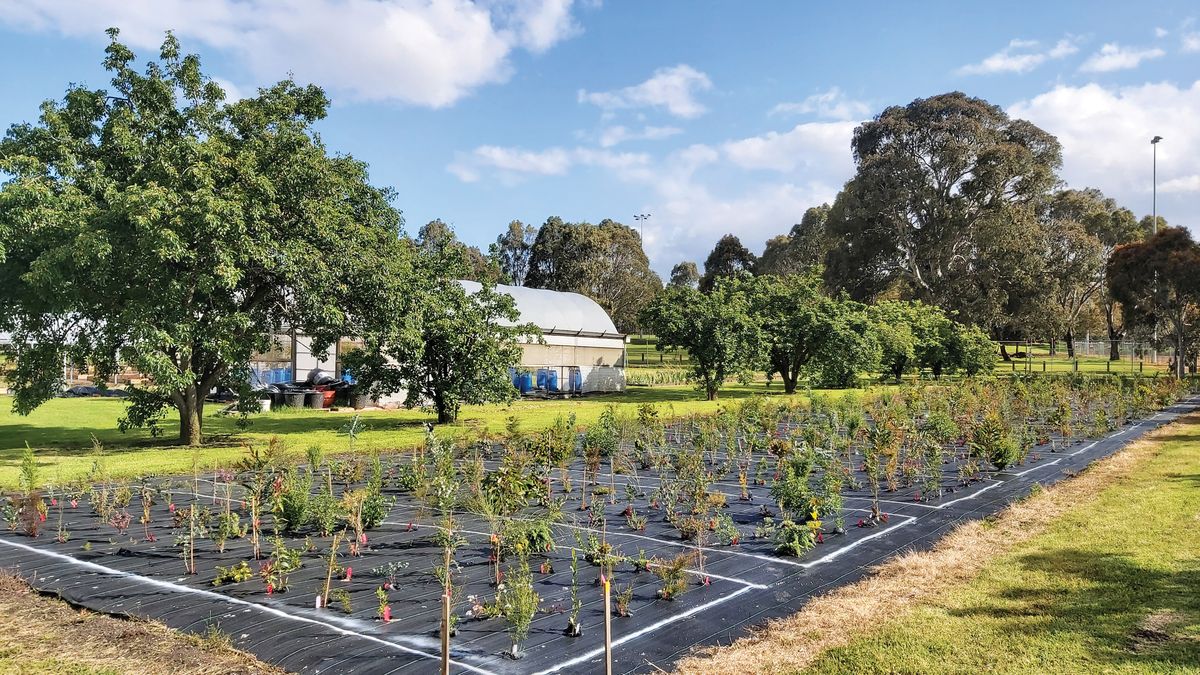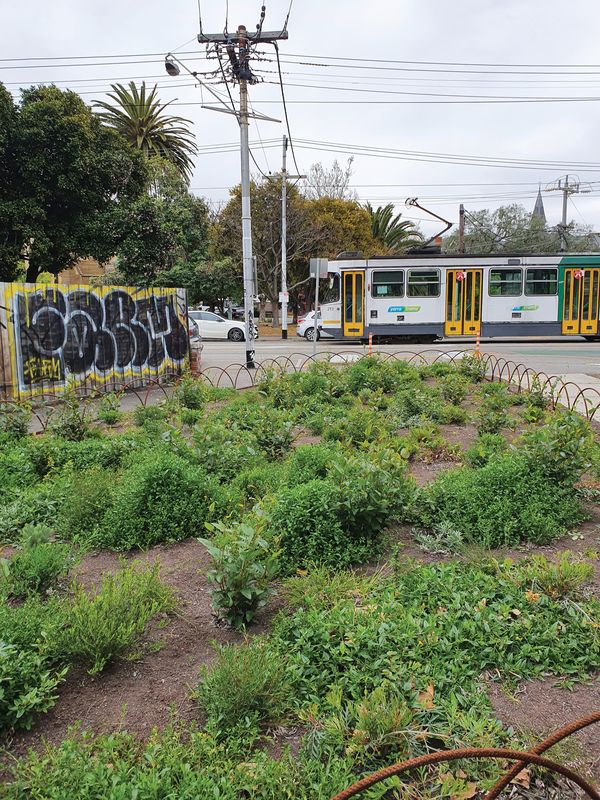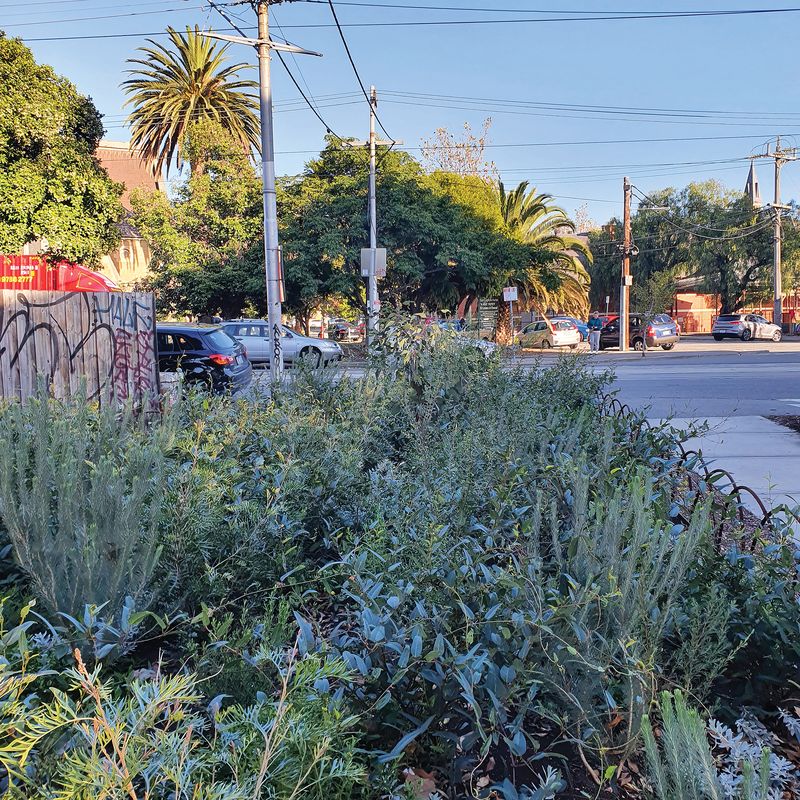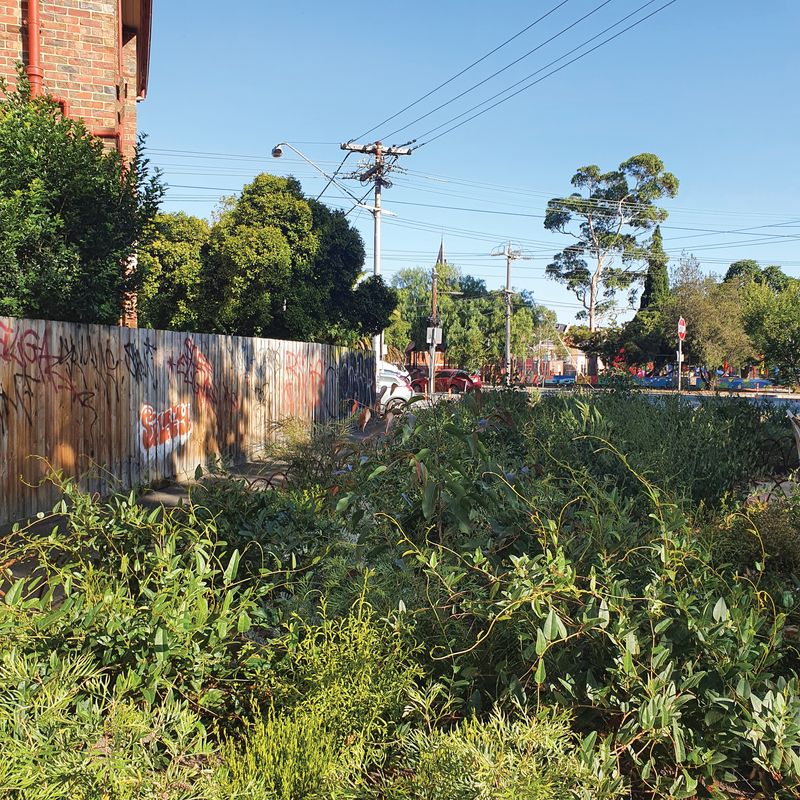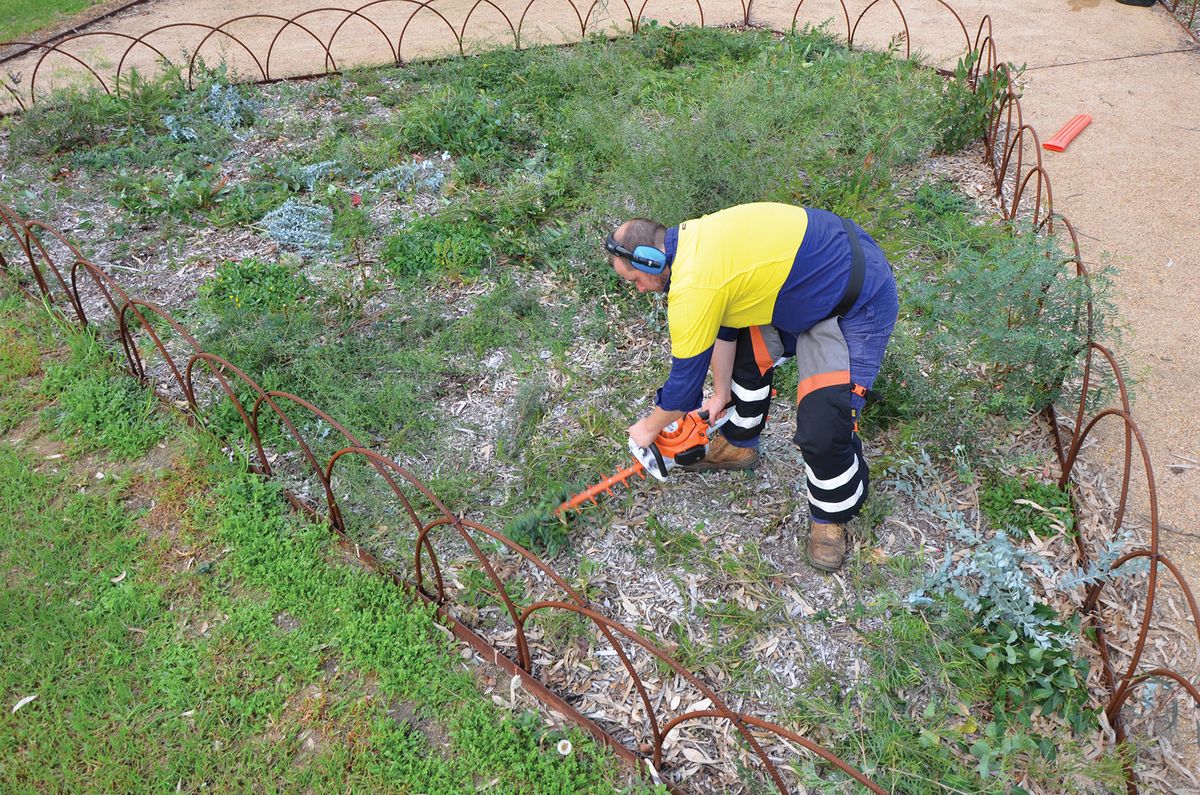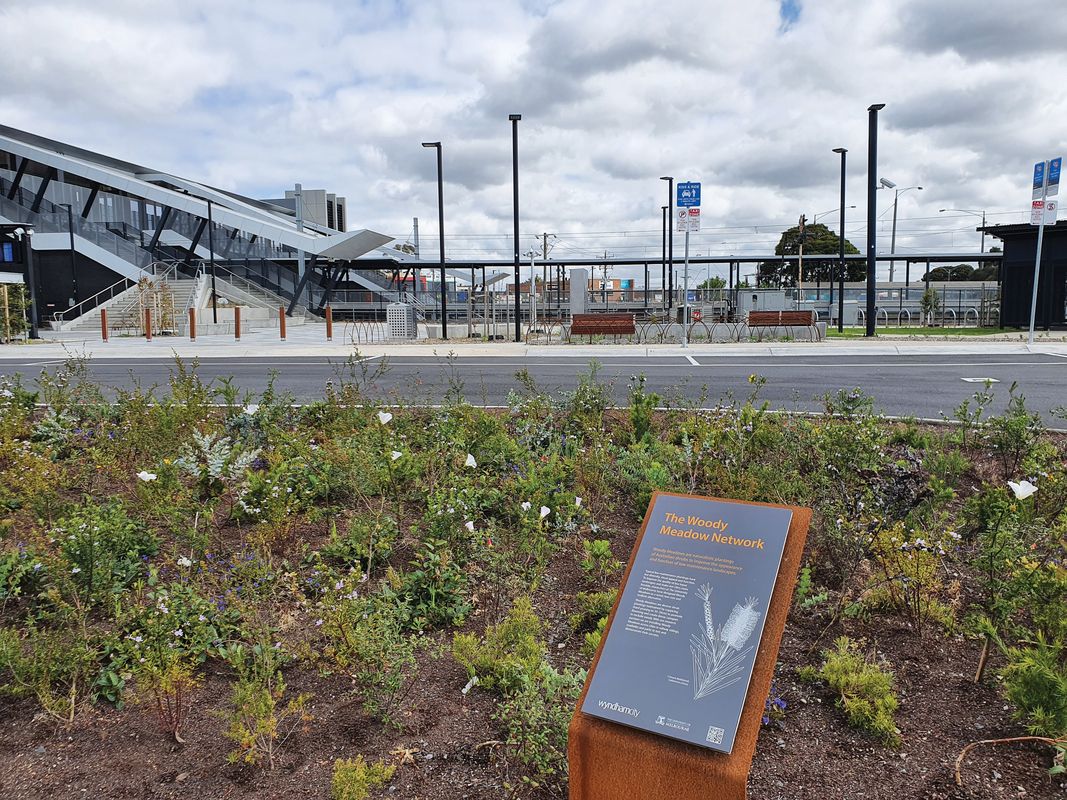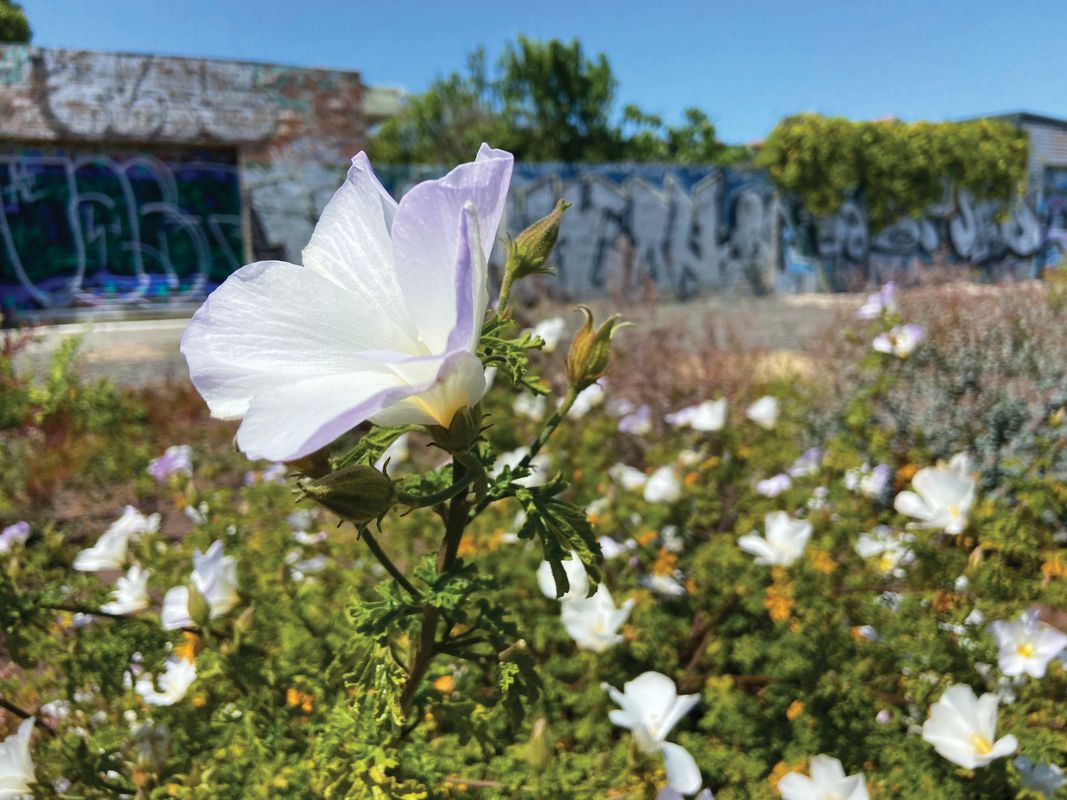The agenda to improve ecological function in hostile urban sites such as railway corridors, roadside verges, roundabouts and nature strips has often been undermined by limited budgets and maintenance access, along with failures of imagination. However, given that these sites add up to more than a third of public green space in Melbourne alone, it’s a mission that holds plenty of promise.1
Established in 2015, the Woody Meadow Project set out to find a low-cost, low-maintenance and resilient approach to urban greening.2 “Woody Meadows” are multi-layered and diverse shrub plantings using Australian native species, which are coppiced every two to four years to achieve rapid canopy cover, exclude weeds and promote flowering. The original research project evaluated the performances of 22 species planted at two Melbourne pilot sites: Birrarung Marr and Royal Park.3
Now, a new phase of the research has significantly expanded the endeavour, attracting partners from across Greater Melbourne that include five local governments, Greater Western Water, Greening the Pipeline and the Victorian Department of Transport and Planning. “We took the pilot project and scaled it up,” says project lead Claire Farrell, an associate professor from the University of Melbourne’s Green Infrastructure Research Group. “It became about how to take this low-maintenance approach and make it relevant to landscapes that might have very different site conditions.”
There are now 6,000 square metres of plantings across Australia, with about 40,000 plants selected from 150 species. There are a further 25,000 square metres of Woody Meadows planned for 2023.4 Researchers argue that the meadows, which are based on habitat templates (usually Australian heathlands or open woodlands), are highly adaptable and resilient and can
be tailored to a range of urban settings.
“We use plants according to the tolerances needed for each site – for example, a shaded Woody Meadow could include low-growing cultivars of Hymenosporum flavum,” Farrell explains. The universal traits a planting must have to achieve Woody Meadow status are: layered, diverse, managed with coppicing and made up of woody Australian native plants. “Everything else about them now is really flexible,” says Farrell.
A typical proportion of plants for each layer is roughly 70 percent low-growing shrubs in the base layer, 25 percent in the mid-layer (shrubs that grow from 1 to 1.5 metres tall), and five percent in the upper layer (shrubs and small trees between 2 and 3 metres high). This layering is intended to mimic the natural form of the community from which the plants are drawn, and to maintain year-round visual interest.
Adjacent to the formal research project, Farrell and her colleagues have established the Woody Meadow Network, which enables cross-pollination and collaboration outside of the prescribed sites. For a small contribution, communities interested in planting a Woody Meadow can gain access to the experts. “We help them out with plant selection and give them guidance around substrates and maintenance,” says Farrell. The network also feeds back information to supply data and lessons from each planting to inform future projects. “All the hurdles that you have in the design process – from approvals through to plant procurement and even the different inorganic substrates – is worked out from project to project. They evolve faster than we can keep up in terms of the research,” says Farrell.
One of the projects from the Woody Meadow Network is the Bothwell Street Woody Meadow, developed in partnership with the City of Port Phillip. It has shown how readily local communities will engage with such planting initiatives. “The site was a dumping ground and not a socially desirable place to hang out,” says Farrell. Since the planting, rubbish is no longer a problem – and when the council came in to coppice the plants, they received complaints from concerned residents. “People called them to say they’d spent money making this beautiful garden and the council didn’t know what they were doing and wrecked it,” Farrell says. As well as demonstrating how the Woody Meadow transformed the previously unloved space into a place people took ownership of, “it also highlighted the need to have signage to explain the process,” Farrell laughs.
In tackling particularly tricky sites, the team’s partnership with several major transport projects – including Melbourne’s Level Crossing Removal Project (LXRP) and the Sydney Metro project – has proven instructive. At the LXRP’s Abbotts Road trial site in Dandenong South, for example, Farrell says the original species selection was heavily constrained by site conditions, and by plant height restrictions most of all. These limitations resulted in a reduced palette of 12 species, only four of which were ever planted due to procurement issues. Instead, the site received inappropriate, non-woody substitutions like Ficinia nodosa.
That situation highlighted a key lesson for achieving successful Woody Meadows. “Because the planting density is high, plant procurement is critical,” explains Farrell, who recommends that participants order plants six months in advance for large projects and ensure design teams approve any suggested substitutions. Fortunately for the LXRP, subsequent plantings have largely been to specification.
As for what constitutes a “diverse” planting, Farrell says that it’s always a balance and varies according to the particularities of the site and the design intent. “One of the most diverse Woody Meadows is one we designed for the City of Brimbank (to be installed later in 2023), which includes 21 species. An aim of this planting is to evaluate a wide range of plants for verge plantings in the council area, so this list includes many more species and a few speculative species, just to try them out.” Conversely, she says, on small sites, it doesn’t make sense to use too much variety – but “fewer than eight species, and it’s doubtful whether it’s a Woody Meadow!”
Another area of focus for the team has been substrate and mulch materials. Experiments with green waste mulches have produced poor results when compared to scoria, which also forms the substrate matter. “Scoria is excellent at suppressing weeds and making the Woody Meadow work. But it is a mined product, and it’s also very regional, so outside of Melbourne it can be difficult to source,” says Farrell.
To that end, PhD student Claire Kenefick is exploring a potential (and widely available) sustainable option: recycled construction waste products. “With Claire’s project, we’re trying to establish whether construction waste products offer an alternative that will reduce weeds, but not inhibit the growth,” Farrell says. High alkalinity is often the biggest issue to overcome when using these materials, though Kenefick has shown that adding organic material to the substrate can make the pH values less hostile. Kenefick is now using the habitat template approach to develop an alkaline-tolerant Woody Meadow plant palette.
The team continues to develop its own guidelines for Woody Meadows across Australia. Project-specific guidelines have already been published, including the City of Melbourne’s “Woody Meadow Pilot Project: Guidelines to Create Diverse Flowering Landscapes” and the Level Crossing Removal Project’s “Woody Meadow Plantings in Level Crossing Removal Project Sites,” which was prepared by Farrell and colleague John Rayner.5 Next, the team is collaborating with Caragh Threlfall at Macquarie University and Dieter Hochuli at the University of Sydney to establish the biodiversity benefits of Woody Meadows, working with local councils in Sydney to install new test sites.
In this UN Decade on Ecosystem Restoration (2021–2030), the Woody Meadow offers an affordable and practical way for communities to create diverse, resilient and adaptable urban green spaces. Of particular benefit for landscape architects, Woody Meadows offer a chance to experiment with more complex plantings in even the most difficult sites. All of those plantings can add up to maximize biodiversity, ecosystem function and the health benefits associated with high-quality urban landscapes.
1.Adrian J. Marshall, Margaret J. Grose and Nicholas S. G. Williams, “From little things: More than a third of public green space is road verge,” Urban Forestry and Urban Greening, vol. 44, August 2019; doi.org/10.1016/j.ufug.2019.126423.
2.Claire Farrell and Rachael Bathgate, “Woody Meadows greening our cities the right way,” Pursuit, The University of Melbourne, 27 March 2023; pursuit.unimelb.edu.au/articles/woody-meadows-greening-our-cities-the-right-way.
3.For a review of the pilot project, see Claire Martin, “Rambunctious research: Planning the life cycle city,” Landscape Architecture Australia, May 2017; landscapeaustralia.com/articles/rambunctious-research.
4.Claire Farrell and Rachael Bathgate, “Woody Meadows greening our cities the right way,” Pursuit, The University of Melbourne, 27 March 2023; pursuit.unimelb.edu.au/articles/woody-meadows-greening-our-cities-the-right-way.
5.Both these guidelines are available at woodymeadow.unimelb.edu.au/fact-sheets/guidelines.
Source
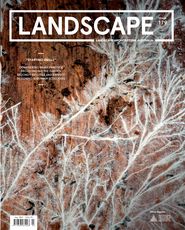
Practice
Published online: 26 Oct 2023
Words:
Lucy Salt
Images:
Ben Ford,
Claire Farrell,
Rachael Bathgate
Issue
Landscape Architecture Australia, August 2023

